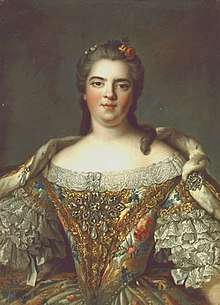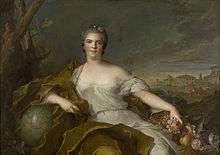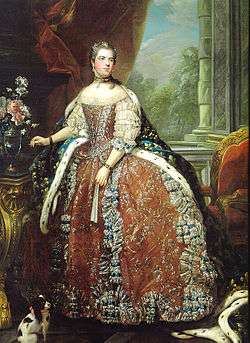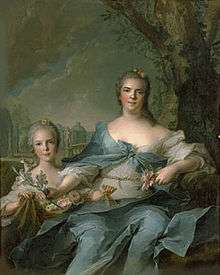Louise Élisabeth of France
| Louise Élisabeth of France | |||||
|---|---|---|---|---|---|
 | |||||
| Duchess of Parma, Piacenza and Guastalla | |||||
| Tenure | 18 October 1748 – 6 December 1759 | ||||
| Born |
14 August 1727 Palace of Versailles, France | ||||
| Died |
6 December 1759 (aged 32) Palace of Versailles, France | ||||
| Burial | Royal Basilica of Saint Denis | ||||
| Spouse | Philip, Duke of Parma | ||||
| Issue |
Isabella, Archduchess of Austria Ferdinand, Duke of Parma Maria Luisa, Queen of Spain | ||||
| |||||
| House | Bourbon | ||||
| Father | Louis XV of France | ||||
| Mother | Maria Leszczyńska | ||||
| Religion | Roman Catholicism | ||||
| Signature |
| ||||
| Styles of Louise Élisabeth, Duchess of Parma as consort | |
|---|---|
| Reference style | Her Royal Highness |
| Spoken style | Your Royal Highness |
| Alternative style | Madame |
Marie Louise Élisabeth of France[1][2][3] (Marie Louise Élisabeth; 14 August 1727 – 6 December 1759) was a French princess, the eldest daughter of King Louis XV of France and his Queen consort, Maria Leszczyńska, and the elder twin of Anne Henriette de France. She married Infante Philip, younger son of Philip V of Spain, who inherited the Duchy of Parma from his mother in 1748, thereby founding the House of Bourbon-Parma. In secondary sources she is referred to also as "Louise Élisabeth of France".[4][5] She functioned as the de facto ruler of the Duchy of Parma between 1748 and 1759.[6]
Life
.jpg)
Early life
Marie Louise Élisabeth de France and her twin Henriette de France were born at the Palace of Versailles on 14 August 1727 to Louis XV of France and queen Maria Leszczyńska. With her younger twin, she was baptised at Versailles on 27 April 1737 with the names of her parents. As the legitimate daughter of the king, she was a fille de France, but was known at court as Madame Royale, Madame Première, Madame Élisabeth, and also as Babette within her family circle.
She was put in the care of Marie Isabelle de Rohan, duchesse de Tallard. Élisabeth was raised at Versailles with her twin, Henriette, their younger sisters Marie-Louise, Marie Adélaïde, and their brother, the Dauphin. Her younger sisters, Victoire, Sophie, Therese and Louise-Marie, however, were sent to be raised in the Abbey of Fontevraud in June 1738.
Élisabeth was not regarded to be as pretty as her twin: her nose was considered too short and too broad, her face too plump, her forehead too high and her complexion too dark and sometimes blotchy.[6] As a person, she was sometimes described as dull and indolent, but usually as vivacious and decided: it was said of her that she "knew how to exact obedience and to get her own way", and she was generally considered as quite charming and a "pleasing, piquant and intelligent personality".[6]
In February 1739, when she was eleven years old, her prospective engagement to the Infante Philip of Spain was announced. Philip was the third son of Louis XV's uncle, Philip V d'Anjou, King of Spain, and Elizabeth of Parma.

This engagement followed a tradition dating back to 1559 of cementing military and political alliances between the Catholic powers of France and Spain with royal marriages. Despite this and the fact that Philip was her father's first cousin, the announcement of the marriage agreement was not well received at the French court, as there was little chance that Philip would become king of Spain, and that only a marriage with a crown prince or a king was deemed worthy of a princess of France.[6] The barrister Barbier wrote in his diary "It seems extraordinary that the eldest Daughter of France is not marrying a crowned head",[6] and d'Argenson speculated that the marriage was arranged only because of a plan to make Don Philip king of Naples and Sicily.[6] Élisabeth herself "considered her destiny to be less glorious than she had the right to expect", and when she was asked if she would not feel pleased to be called Infanta, her face reportedly "contracted into a scornful grimace".[6]
The twelve-year-old Élisabeth was married by proxy in Versailles on 26 August 1739, and thereafter known as Madame Infanta in France. In September, she left for Spain, and the king was reportedly so moved that he entered her carriage and accompanied her for the first miles on her journey. She passed the border and met her nineteen-year-old husband some thirty kilometers northeast of Madrid, at Alcalá de Henares, where the marriage ceremony took place on 25 October 1739.
Infanta of Spain
Élisabeth made a personal success upon her arrival in Spain and was soon the "idol of Madrid".[6] She made a favorable impression on her father-in-law, king Philip V, and upon her spouse, prince Philip. Her relationship with her mother-in-law, the domineering queen Elisabeth of Parma, however, soon became one of mutual dislike. The queen was displeased over the fact that Élisabeth's dowry was not paid by France, nor did France assist Spain in the war with Britain;[6] further more, after about six months the queen reportedly realized that she would not be able to control or dominate Élisabeth, as she was accustomed to do with her husband and son, and that her daughter-in-law could potentially replace her own influence over her son.[6] As a result, Elisabeth spent most of her time away from the Queen, playing with dolls and wrote of her unhappiness to her father.

Élisabeth soon came to dominate Philip; though he was eight years her senior, he, as his father, was reportedly of a timid, passive and submissive nature, and Élisabeth reportedly felt affection for him but generally treated him as "a boy much younger than herself although he was her senior by eight years".[6] de Luynes later observed: "Although the Prince at twenty-eight is as much of a child as he was at fourteen or fifteen, he has, nevertheless, an affectionate regard for the Infanta."[6]
Élisabeth is described as "keen, ambitious and enterprising, untiring in her energies and passionately fond of her changing Europe to the advantage of her House, of imbuing everyone with a love for France and of making her son a prince worthy of his great French forefathers".[6] She was not satisfied with her powerless position as the spouse of a prince with not prospects of being queen at the Spanish courts; she kept in contact with the French court through correspondence, in particular with her twin, informed her brother the Dauphin of all events at the Spanish court, and had already by 1740 established a net of contacts at the French court to assist her in her ambition to obtain an independent power position for herself and her spouse, "worthy of the birth of both".[6] Her twin Henriette, otherwise regarded as habitually apathetic of politics and gentle, was reportedly passionately devoted to work for the political ambition of her elder twin Élisabeth, as did her younger sister Adelaide and her sister-in-law Infanta Maria Teresa Rafaela of Spain; the powerful Noailles and Jean-Frédéric Phélypeaux, Count of Maurepas allied with the queen to achieve the same, and the French ambassador at Madrid, Monseigneur Vaurdal, Archbishop of Reims, was reportedly so willing to be of assistance that he was ridiculed for it.[6]
In 1741, Philip was called to serve in the War of the Austrian Succession, through which it was hoped that he would be able to secure one of the duchies of Northern Italy.[6] Her mother-in-law Queen Elisabeth reportedly made sure that Philip stayed in camp for almost all of the War, separated from his wife, in order to avoid her from replacing his mother in his affection; through their correspondence, the queen repeatedly asked her son if he loved his wife: "I want to know if you love . : [the sign which Elisabeth Farnese used to denote her daughter-in-law when writing to her son] Tell me the truth!"[6] Despite the mutual antipathy between Élisabeth and her mother-in-law the queen, however, they were in fact united in their ambition and work to provide prince Philip with an independent power position.[6] During the war, Queen Elisabeth worked to secure her son Philip a throne in Italy, at the same time as her daughter-in-law used all her resources of her net of contacts to do the same. They succeeded in their common ambition in the Treaty of Aix-la-Chapelle (1748), when Philip was made ruler of the Duchy of Parma.
Duchess of Parma
In the Treaty of Aix-la-Chapelle (1748) which ended the War of the Austrian Succession, Holy Roman Empress Maria Theresa had to cede the duchies of Parma, Piacenza and Guastalla to Ferdinand VI of Spain. At Louis XV's instigation, Philip became Duke and of Parma, thus successfully achieving the ambition of both Élisabeth and her mother-in-law queen Elizabeth Farnese.

Élisabeth was pleased with her new position and with leaving the powerless position she had occupied at the court of Spain. However, she felt it necessary to obtain a substantial income of their own rather than to be solely provided for by Spain, as that would in practice make them but vassals of Spain, and therefore left Madrid for the French court with the ambition to secure an income to Parma from her father.[6]
Élisabeth was met in Choisy by her twin and her brother the Dauphin, she arrived in Versailles in 11 December 1748 with her retinue, composed of her camarera mayor the Marquise de Lcyde, her secretary of state the Duque de Monteiano as major domo-in-chief, and three and three maids-of-honour.[6] The French court was amassed over her lack of pomp and elegance; it was said that she arrived in nothing more than what was absolutely necessary, and that she did not appear to own more clothes than what she had brought with her from France nine years earlier.[6] She was described as clever, quick and practical, with a robust strength of mind, and efficiently focused on state affairs.[6] A courtier described Élisabeth as "charming" and as having "piercing eyes" that "express(ed) intelligence" while another, less sympathetic observer claimed she looked like a "well-endowed young woman, matured by motherhood".[7] During her several-month stay in Versailles, she spent most of her time with her father the king, who several times daily went to her room via a private staircase to discuss business with her, and she successfully achieved her goal when her father granted two hundred thousand francs for the Duke of Parma.[6] Her strong will and influence on her father reportedly somewhat worried his maîtresse-en-titre, Madame de Pompadour.[6] When she left Versailles on 18 October 1749, she brought a French retinue of followers, a trosseau and so many gowns that D’Argenson commented that her journey had cost the State twelve hundred thousand livres.[6]

In December 1749, Élisabeth and her retinue of Spanish and French courtiers arrived in the Duchy of Parma, where they were welcomed by Philip and greeted by public celebrations in her honor. In Parma, she and her Philip lived in the Ducal Palace of Colorno. [8] Before the former duke of Parma, Philip' brother Charles, and left Parma to become king of Naples, he had reportedly stripped the palace in Parma of much of its interior decoration and furniture, and the residence also lacked a garden. Élisabeth spent great sums to create a residence and a host a court life to her taste; the whole arrangement and plan of the residence was redesigned, and she organised a ceremonial court life and hosted numerous festivities such as opera six times a week and trips to the second residence in Colonna and Piacenza.[6] To enforce the status of the Duchy, she also introduced the presence of a regiment of one hundred carbineers and a regiment of curassiers, despite the fact that the Duchy was in fact formally under the protection of France and Spain.[6]
As duchess of Parma, Élisabeth actively involved in state affairs; Philip never negotiated any business without consulting her, and she in turn never made a decision without considering the view of France and her French advisers.[6] Most of the officials of the court and government were French, and French was the language spoken at court, even by Philip, while she herself demonstratively promoted French influence in the duchy.[6] The French influence in Parma was not popular in the Duchy, opposition among the Italian public raged against both the French and Spanish rulers.[6] In 1750, Elisabeth's lady-in-waiting Madame de Leydc was claimed by a rumor to have poisoned France's Chief Minister at Parma, supposedly for being French.[6] The financial stress of the duchy was extensive, however, which created a problem.[6]
Élisabeth's twin sister Henriette died in 1752, and Élisabeth returned to France in September, visiting her tomb at Saint-Denis and remaining in Versailles for almost a year. She brought with her the duke de Noailles, who assisted her in the political transactions she held with her father during her stay, helping her to navigate between the party fractions at court. Élisabeth presented Louis XV and his ministers with a report of the state of Parma, stressing its financial need.[6] The duke de Noailles was sent to the French ambassador in Madrid to open negotiations between France and Spain regarding the contributions of the Duchy of Parma in January 1753, in which Élisabeth participated with all her contacts in France and Spain, supporting the French suggestion that France and Spain would share the expenses of the Duchy of Parma if the latter could guarantee her independence.[6] By the Franco-Spanish agreement of 1753, the Duchy of Parma was granted twenty five thousand francs, two millions in taxes and supplementary assistance when needed, in addition to making French influence in Parma formal and officially legal.[6] Elisabeth was hailed and praised in France for securing the French influence abroad by this agreement, in which she had played a vital part.[6]
.jpg)
Élisabeth returned to Parma in October 1753. Upon her return, she appointed Guillaume du Tillot as chief minister and administrator of the principality, securing both her own pro-French policy as well as marking France's de facto conquest of Parma.[6] In her policy, Élisabeth worked to free Parma from Spanish influence; to secure the succession of the duchy for her son and if possibly obtain a greater throne for him with French help; and to secure dynastic marriages for her daughters.[6] In accordance with her ambitions, she viewed Spain as her enemy and therefore supported the Treaty of Versailles of 1756, which allied France with Austria.[6] In the Treaty, it had been suggested that Austria would cede the Austrian Netherlands as a kingdom for Philip, which would be even more favorable for France than to have Parma as a vassal, a plan which was supported by both Elisabeth and Louis XV.[6] In this plan, she worked together with Madame de Pompadour to secure the Franco-Austrian alliance, and they also joined in their support of Choiseul.[6]
Élisabeth returned to France again in September 1757, to attend the negotiations between France and Austria. In the issue of Austria's wish to make the Austrian Netherlands a Kingdom for Philip in exchange for retrieving Silesia from Prussia with the support of France, she supported the idea, as it would mean a final liberation from the tutelage of Spain: "We shall not be happy until we get rid of them! This sentiment is more human than Christian. I am not sufficiently good to resist it!"[6] She did however not succeed in her efforts. In the treaty between Spain and Austria on the 3 October 1759, supported by Choiseul, the right of Philip in the Treaty of 1748 to succeed to the throne of Naples and Sicily should his brother Charles inherit the throne of Spain, was a great disappointment to her.[6] During her stay in France, she kept in contact with Philip by letters and informed him of her acts, negotiations, hopes and successes, as well as the intentions and actions of Louis’ Government. During this time, Elisabeth also appointed the philosopher Condillac as her son's tutor despite the opposition of the Jesuits, and arrange the marriage of her daughter Isabella to the Archduke Joseph of Austria, the future Emperor Joseph II, which took place in 1760.
Élisabeth fell ill while she was at Versailles, and died of smallpox on 6 December 1759 and was buried on 27 March 1760 at Saint-Denis Basilica beside her twin, Henriette. Their tombs were desecrated in 1793, during the French Revolution.
Issue
- Isabella Maria Luisa Antonietta Ferdinanda Giuseppina Saveria Dominica Giovanna (1741–1763) who later married the Austrian emperor, Joseph II, queen Marie Antoinette's older brother.
- Ferdinand Maria Filippo Lodovico Sebastiano Francesco Giacomo (1751–1802) who succeeded his father as Duke of Parma in 1765 and married Archduchess Maria Amalia of Austria, his older sister's sister-in-law, and left issue.
- Luisa Maria Teresa Ana (1751–1819), known as Maria Luisa who married Infante Charles of Spain, her cousin, and later became the Queen consort of Spain.
Ancestry
| Ancestors of Louise Élisabeth of France[9][10] | ||||||||||||||||||||||||||||||||||||||||||||||||||||||||||||||||||||||||||||||||||||||||||||||||||||||||||||||||||||||||||||||||||||||||||||||||||||||||||||||||||||||||||||||||||||||||||||||||||||||||||||||||||||||||||||||||||||||||||||||||||||||||||||||||||||||||||||||||||||||||||||||||||||||||||||||||||||||||||||||||||||||||||||||||||||||||||||||||||||||||||||||||||||||||||||||||||||||||||||||||||||||||||||||||||||||||||||||||||||||||||||||||||||||||||||||||||||||||||||||||||||||||||||||||||||||||||||||||||||||||||||||||||||||||||||||||||||||||||||||||||||||||||||||||||||||||||||||||
|---|---|---|---|---|---|---|---|---|---|---|---|---|---|---|---|---|---|---|---|---|---|---|---|---|---|---|---|---|---|---|---|---|---|---|---|---|---|---|---|---|---|---|---|---|---|---|---|---|---|---|---|---|---|---|---|---|---|---|---|---|---|---|---|---|---|---|---|---|---|---|---|---|---|---|---|---|---|---|---|---|---|---|---|---|---|---|---|---|---|---|---|---|---|---|---|---|---|---|---|---|---|---|---|---|---|---|---|---|---|---|---|---|---|---|---|---|---|---|---|---|---|---|---|---|---|---|---|---|---|---|---|---|---|---|---|---|---|---|---|---|---|---|---|---|---|---|---|---|---|---|---|---|---|---|---|---|---|---|---|---|---|---|---|---|---|---|---|---|---|---|---|---|---|---|---|---|---|---|---|---|---|---|---|---|---|---|---|---|---|---|---|---|---|---|---|---|---|---|---|---|---|---|---|---|---|---|---|---|---|---|---|---|---|---|---|---|---|---|---|---|---|---|---|---|---|---|---|---|---|---|---|---|---|---|---|---|---|---|---|---|---|---|---|---|---|---|---|---|---|---|---|---|---|---|---|---|---|---|---|---|---|---|---|---|---|---|---|---|---|---|---|---|---|---|---|---|---|---|---|---|---|---|---|---|---|---|---|---|---|---|---|---|---|---|---|---|---|---|---|---|---|---|---|---|---|---|---|---|---|---|---|---|---|---|---|---|---|---|---|---|---|---|---|---|---|---|---|---|---|---|---|---|---|---|---|---|---|---|---|---|---|---|---|---|---|---|---|---|---|---|---|---|---|---|---|---|---|---|---|---|---|---|---|---|---|---|---|---|---|---|---|---|---|---|---|---|---|---|---|---|---|---|---|---|---|---|---|---|---|---|---|---|---|---|---|---|---|---|---|---|---|---|---|---|---|---|---|---|---|---|---|---|---|---|---|---|---|---|---|---|---|---|---|---|---|---|---|---|---|---|---|---|---|---|---|---|---|---|---|---|---|---|---|---|---|---|---|---|---|---|---|---|---|---|---|---|---|---|---|---|---|---|---|---|---|---|---|---|---|---|---|---|---|---|---|---|---|---|---|---|---|---|---|---|---|---|---|---|---|---|---|---|---|---|---|---|---|---|---|---|---|---|---|---|---|---|---|---|---|---|---|---|---|---|---|---|---|---|---|---|---|---|---|---|---|---|---|---|---|---|---|---|---|---|---|---|---|---|---|---|---|---|---|---|---|---|---|---|---|---|---|---|---|---|---|---|---|---|---|---|---|---|---|---|---|---|---|---|---|---|---|---|---|---|---|---|---|---|---|---|---|---|---|---|---|---|---|---|---|---|---|---|
| ||||||||||||||||||||||||||||||||||||||||||||||||||||||||||||||||||||||||||||||||||||||||||||||||||||||||||||||||||||||||||||||||||||||||||||||||||||||||||||||||||||||||||||||||||||||||||||||||||||||||||||||||||||||||||||||||||||||||||||||||||||||||||||||||||||||||||||||||||||||||||||||||||||||||||||||||||||||||||||||||||||||||||||||||||||||||||||||||||||||||||||||||||||||||||||||||||||||||||||||||||||||||||||||||||||||||||||||||||||||||||||||||||||||||||||||||||||||||||||||||||||||||||||||||||||||||||||||||||||||||||||||||||||||||||||||||||||||||||||||||||||||||||||||||||||||||||||||||
References
- ↑ Achaintre, Nicolas Louis, Histoire généalogique et chronologique de la maison royale de Bourbon, Vol. 2, (Publisher Mansut Fils, 4 Rue de l'École de Médecine, Paris, 1825), p. 154.
- ↑ American Historical Association, The American historical review, Volume 10, The Macmillan Company, 1905, 707.
- ↑ Pajol, Charles Pierre Victor, Les guerres sous Louis XV, Vol. 2, (Imprimeurs de L'Institut, Rue Jacob, Paris, 1883), 7: .. à Louise-Elisabeth de France, fille de Louis XV, née le 14 aout 1727, morte le 6 décembre 1759...
- ↑ Campbell Orr, C. (ed.) Queenship in Europe 1660–1815: the role of the consort. Cambridge: Cambridge University Press, 2004, pp. 166, 171.
- ↑ Hyde, M. and Milam, J. (eds.) Women, art and the politics of identity in eighteenth-century Europe. Aldershot: Ashgate, 2003, pp. 130, 132, 306.
- 1 2 3 4 5 6 7 8 9 10 11 12 13 14 15 16 17 18 19 20 21 22 23 24 25 26 27 28 29 30 31 32 33 34 35 36 37 38 39 40 41 42 43 Latour, Louis Therese, Princesses Ladies And Salonnieres of The Reign of Louis XV, 1927
- ↑ Lévêque, Jean-Jacques, Versailles: The Palace of the Monarchy, The Museum of the Nation, translated by Kirk McElhearn and Ellen Krabbe, ACR PocheCouler, Paris, 2000, p. 113.
- ↑ "WALL LIGHTS, LOUIS XV, CIRCA 1752–1753 FROM THE DUCHESSE DE PARME AT COLORNO". Sothebys.
- ↑ Genealogie ascendante jusqu'au quatrieme degre inclusivement de tous les Rois et Princes de maisons souveraines de l'Europe actuellement vivans [Genealogy up to the fourth degree inclusive of all the Kings and Princes of sovereign houses of Europe currently living] (in French). Bourdeaux: Frederic Guillaume Birnstiel. 1768. p. 12.
- ↑ Żychliński, Teodor (1882). Złota księga szlachty polskiéj: Rocznik IVty (in Polish). Jarosław Leitgeber. p. 1. Retrieved 1 August 2018.
Notes
- The majority of this article is based on a translation of the equivalent article of the French Wikipedia on 6 November 2006
Further reading
- Sanger, Ernest, Isabelle de Bourbon-Parme: la Princesse et la Mort, Racine, Brussels, 2002.
- Zieliński, Ryszard, Polka na francuskim tronie Czytelnik, 1978.
Louise Élisabeth of France Born: 14 August 1727 Died: 6 December 1759 | ||
| French royalty | ||
|---|---|---|
| Preceded by Princess Marie Thérèse of France |
Madame Royale 1727–1739 |
Succeeded by Marie Thérèse of France |
| Spanish royalty | ||
| Preceded by Elisabeth Christine of Brunswick-Wolfenbüttel |
Duchess consort of Parma, Piacenza and Guastalla 1748–1759 |
Succeeded by Archduchess Maria Amalia of Austria |